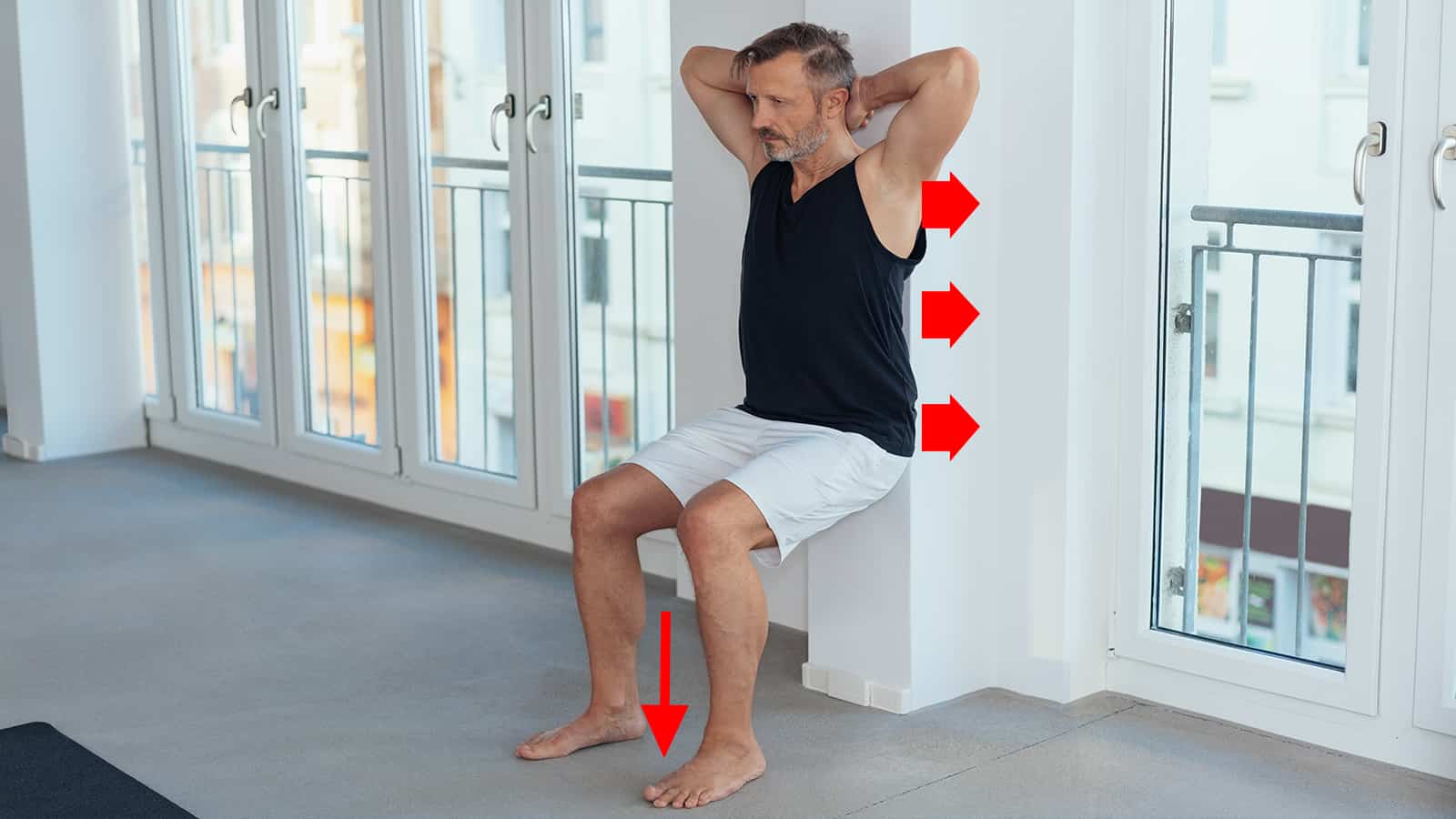Isometric exercises are when you tense your muscles but don’t move them. Many people believe that training requires lots of movement, but these exercises prove otherwise. These exercises are low-impact, and you can do them with no gym equipment, no matter where you are.
When doing isometric exercises, you strengthen your muscles by holding them in certain positions. You will maintain the poses for at least six seconds at a time, being careful not to move. These exercises make your muscles work overtime, strengthening them in ways other activity doesn’t.
You can do these exercises with weight-lifting or resistance training for optimal benefits. The activities often include yoga poses or Pilates but aren’t limited to those areas. With regular use of these methods, you’ll notice improved muscle endurance.
If you aren’t familiar with isometric exercises yet, this article will tell you all you need to know. Plus, it includes quite a few bodyweight exercises to help get you started.
How Isometric Exercises Work
You’ve likely done these exercises before without realizing it. Anytime you experience tension in your muscles, and your joints aren’t moving. It sounds easy, but holding still while contracting your muscles is challenging.
These exercises work because they activate your muscle fibers. When equal forces act against each other, but there isn’t any movement, it triggers the muscle fibers, building strength. You can target specific muscles, too, allowing you to use them to achieve your goals.
Static exercises don’t only strengthen the muscles, either. As you do these bodyweight exercises, your muscle tissues fill with blood and create metabolic stress. The metabolic stress increases physical endurance and stabilizes the muscles.
Eight Benefits of Isometric Exercises
Studies show that these exercises have a range of health benefits, including:
- Lower blood pressure
- Higher pain threshold
- Improved jump height
- Increased kicking ability
- Quicker recovery after surgery or an injury
- Decreases symptoms of rheumatoid arthritis
- Improves muscle stability
- Decreases pain in the lower back
Health benefits aren’t the only thing you have to look forward to. Other benefits include the following:
- No gym equipment
- It can be performed anywhere
- Targeting specific areas without straining joints
- Requires less practice to develop good form
- Safe for those with restricted movement
Risks of Isometric Exercises
Similar to any form of exercise, these exercises come with some risks. While they are less intense for major muscle groups than other dynamic movements, they can still affect injuries. You shouldn’t perform these exercises unless your doctor clears you to do so after an injury or surgery.
Tips to Keep in Mind When Starting Isometric Exercises
Remember to squeeze your muscle as you hold each pose. Since you aren’t relying on movement to fatigue your muscles, you must tighten them to reach that point. Tighten up your muscles as much as possible, but stop if it becomes painful.
It is also essential that you remember to breathe correctly. When you tense up your muscles, it’s natural to want to hold your breath, but it isn’t suggested. Your muscles require oxygen to enhance performance, so you’ll want to focus on your breathing.
The proper way to breathe during static exercises is to fill up your belly with air on the inhale. On the exhale, push the air out through your nostrils until your belly contracts. Continue inhaling and exhaling this way throughout the exercises.
You’ll also want to ensure that you maintain proper form to avoid injury. If you don’t stick to the position, it could damage your shoulders or lower back. Plus, you can only target your muscles effectively if you hold the pose correctly.
Don’t overdo it, even if you want to keep pushing. If you can’t hold the correct position anymore, it’s time to stop. Anytime the pose doesn’t feel right, move on to another one and try that one again another day.
Another tip is to switch it up every day. Do different isometric exercises, and mix in other types of movement, too. You don’t have to give up running when you take up isometric options.
Try These Eight Isometric Exercises
Now that you know what isometric exercises are and how to do them properly, it’s time to get started. Here are a few of the best static exercises to begin with, but you can add them to your routine at any time.
1. Wall Sit
Wall sits are a simple but powerful leg workout, targeting the glutes, quadriceps, and hamstrings. They also strengthen the hips and promote balance. Stand about two feet away from the wall with your feet shoulder-width apart. Then, lean toward the wall so that your back is flat against it.
Slide down the wall slowly until your thighs are parallel to the ground. You’ll be in a sitting position but using the wall for support. Make sure your knees don’t go out past your toes, and don’t put too much pressure on your knees.
Flex your legs as tightly as you can, and hold them for six to fifteen seconds, repeating the action two or three times. You should also keep your core tight so that you feel tension there, too.
2. Triceps Extension Against the Wall
Triceps extension against the wall works your triceps. You’ll start in a lunge position, but put your palms on the wall at head level. Then, use your triceps to push your hands into the wall. Don’t tense your shoulders during the exercise, and make sure you breathe deeply.
3. Glute Bridge
The glute bridge targets the gluteal muscles, which are behind the quadriceps. You’ll start by lying on your back with your knees bent upward. Keep your knees planted flat on the floor and extend your arms with your palms facing upward.
Then, engage the core muscles as you lift your hips off the ground until your torso is in a straight line. Use your arms throughout the exercise for stability, and hold the post until you can’t anymore. Do this exercise two or three times, holding for thirty seconds each time if you can.
4. Low Squat
A low squat works your glutes, quads, and adductors. You’ll start with your feet shoulder-width apart before squatting until your thighs are parallel to the floor. Once you become comfortable holding the position, push yourself by squeezing your feet inward without actually moving them.
When you try to squeeze your feet together, your inner thigh muscles will contract even more. Make sure your knees don’t go in front of your toes, or you won’t sit back far enough.
While squatting does require moving down into a sitting position, the muscle tension happens while you stay still. Hold the squat for ten to thirty seconds before returning to the starting position. Repeat the activity three to five times or until your muscles become fatigued.
5. Self-arm Wrestling
Arm wrestling with yourself sounds silly, but it’s an effective way to work out your biceps and triceps. You’ll start by bending your right arm at a 90-degree angle and then grab your right hand with your left. Push your hands together as hard as you can without moving them in either direction.
After six to fifteen seconds, switch to the other arm. Don’t tense your shoulders while you do it. The focus should be on using your biceps to prevent your arm from dropping and your triceps to push your arm down.
6. Forearm Plank
The forearm plank works your abs, but you must focus on your form. Keep your spine straight and tighten your abs as much as you comfortably can. Don’t let your butt fall or go too high, as your shoulders, hips, knees, and ankles should align.
7. Bent-over Press Against the Wall
The bent-over press against the wall works your shoulders. You’ll start in a low lunge position with your hands on the wall at chest level. Then, you’ll lean into the wall and push, staying upright. The lower you go into the lunge position, the more exercise your shoulders receive. Staying upright allows it to work out your chest, too.
8. Side Plank
The side plank works your obliques, spinal stabilizers, quadriceps, glutes, serratus anterior, shoulder stabilizers, and hip abductors. You’ll want to start by lying on your left side with your legs straight. Keep your hips, knees, and feet stacked over one another.
Then, bend your left elbow and place your forearm on the ground directly beneath your shoulder. Push your left forearm into the ground and lift your torso and hips. As you do this, keep your core tight and body straight.
You can keep your other arm straight in the air or by your side. Hold the position for at least ten seconds before switching sides.
Final Thoughts on What Are Isometric Exercises? Try These Eight Moves
You can do isometric exercises anywhere, as most don’t require any equipment. They are quick workouts that make a big difference. Consistently doing these exercises builds muscle and tones your body.
Combine these exercises with other workouts for optimal results. You’ll quickly feel stronger and more toned, and you’ll be able to push yourself further. Try these eight moves to get started, but don’t be afraid of branching out after a while.
















 Community
Community

